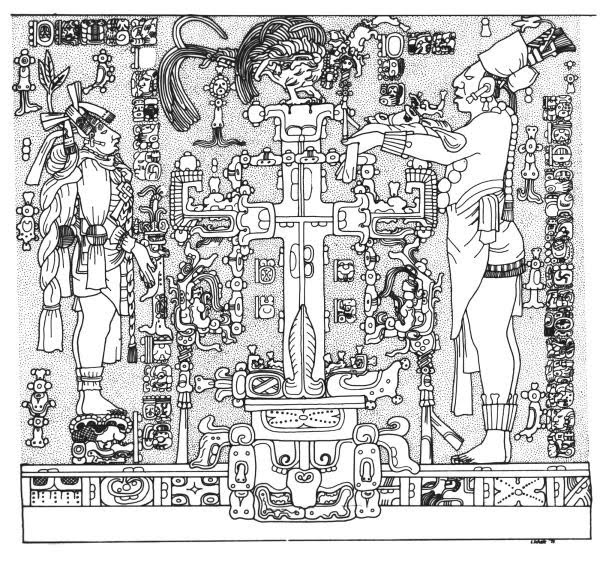It has long been known that in the Classic Maya language of the inscriptions, the word for 'sky', chan, is often expressed or replaced with glyphs for 'four' or 'snake'. This wordplay, which has persisted in many modern Mayan languages across the centuries, happens to illuminate several previously-impenetrable Mayan images with meaning. Thus, for example the Classic Maya image of the World Tree as being bedecked with foliage with its cross like central bar represented as a double-headed serpent makes more sense when one considers that the Classic Maya translation of 'world tree' was wakah chan.
|
Across the various Mayan languages, whether ancient, colonial or modern, there exists a nexus of words and wordplays centred on the sounds chan, kan, k'an and ka'an which reveal interesting dimensions to Mayan conceptions of the sky. This wordplay symmetry is broken however in Tzotzil, a language of the highlands of Chiapas, where the word for sky is vinajel, but it nonetheless demonstrates something fascinating about the Mayan cosmovision.
It has long been known that in the Classic Maya language of the inscriptions, the word for 'sky', chan, is often expressed or replaced with glyphs for 'four' or 'snake'. This wordplay, which has persisted in many modern Mayan languages across the centuries, happens to illuminate several previously-impenetrable Mayan images with meaning. Thus, for example the Classic Maya image of the World Tree as being bedecked with foliage with its cross like central bar represented as a double-headed serpent makes more sense when one considers that the Classic Maya translation of 'world tree' was wakah chan.
0 Comments
One of the favoured philosophical concepts among visionaries and seekers of the past century or so has been Kant's idea of the noumenon, which implicitly or explicitly rests in the worldviews of a variety of thinkers on the subjects of spirituality, mythology and visionary art and experience. I think particularly of Joseph Campbell and Mircea Eliade in this regard. In this chapter, however, we find that a quantum mechanical view renders the noumenon as meaningless, suggesting it reflects a fundamental human instinct or expectation, rather than an insight into the true nature of reality. What are we to do with this quantum worldview which strikes at the heart of the human experience of a cosmos driven by forms, essences and a perceived objectivity and eternity, rendering them meaningless and indeterminate? We can perhaps agree on an 'objective' reality on the human scale, with human perception and instruments of enquiry offering windows into that external realm, but a key issue is what our conceptions of that realm should be founded upon. Scientists often concur that we can be sure of an 'objective' external reality (and to my mind, these two attributes are not the same) because of the consistency this reality offers to experimental observation.
It might seem a little strange for a blog about prehistoric artforms and cultural realities to engage in a discussion about quantum mechanics, but as outlined in the Introduction, a sojourn around some relevant scientific theories will eventually - at length! - bring us to a radically new image of the visionary human being. This overview of quantum mechanics is the first step in this journey, which will take in pertinent aspects of human neurology, Darwinism, linguistics and signal theory, and while patience is required to move through each aspect, the destination will be - I hope! - one of profound quality and insight for the 21st century. I should also remark that I don't consider quantum mechanics to be a difficult discipline as such - strange for sure and profoundly absurd from a human perspective, but not difficult - though I am aware that some will find it challenging or disconcerting to engage with. Another point to note is that those expecting to see a validation of 'quantum mysticism' ideas of 'universal consciousness' will be here sorely disappointed! Most modern students of a scientific field will be familiar in some way with the quantum phenomenon of wave-particle duality in which elementary particles such as electrons and photons exhibit properties that are particle-like in some situations and wave-like in others, and this example of complementarity is a fundamental property of the universe. Let us look at this duality in some detail, and the manner of its discovery, so that we can understand its import.
|
ARCHAIC VISIONS
|






 RSS Feed
RSS Feed






